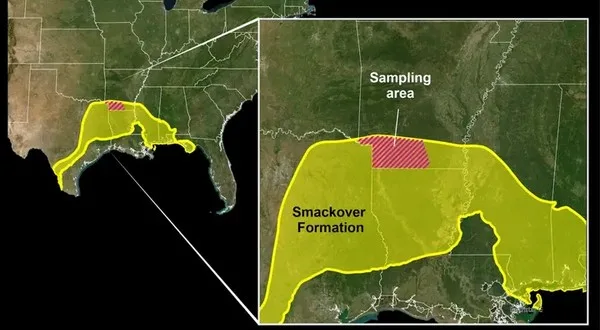
(Photo courtesy of U.S. Geological Survey)
A recent study by the U.S. Geological Survey (USGS) has identified significant lithium reserves in southwestern Arkansas, potentially addressing the increasing demand for lithium in electric vehicle batteries.
Collaborating with the Arkansas Department of Energy and the Environment’s Office of the State Geologist, the USGS investigated the Smackover Formation to assess the lithium content in brines generated during oil and gas exploration. The findings estimate lithium reserves in the formation to be between 5 million and 19 million tons.
While this estimate represents the total amount present, it does not indicate how much could be technically extracted. However, if recoverable, even the lower estimate of 5 million tons could satisfy the projected global demand for lithium batteries in electric vehicles by 2030 nine times over.
Lithium, a vital mineral, has seen a surge in global demand, driven by the shift from fossil fuels to electric and hybrid vehicles, as it is essential for rechargeable batteries. Additionally, lithium is used in manufacturing glass, aluminum products, portable electronics, and electric tools, as well as for energy grid storage.
Katherine Knierim, a hydrologist and the principal researcher of the study, stated, “Our research was able to estimate total lithium present in the southwestern portion of the Smackover in Arkansas for the first time. We estimate there is enough dissolved lithium present in that region to replace U.S. imports of lithium and more.”
Knierim also cautioned that the current estimates are only in-place assessments and do not reflect what could be technically extracted using modern methods.
To conduct the study, the USGS employed machine learning to analyze brine samples from the Smackover Formation, comparing them to existing USGS databases. This technology enabled the prediction of lithium concentrations throughout the region, including areas without previous sample data.
USGS Director David Applegate emphasized the significance of the study, stating, “Lithium is a critical mineral for the energy transition, and the potential for increased U.S. production to replace imports has implications for employment, manufacturing and supply-chain resilience. This study illustrates the value of science in addressing economically important issues.”
Currently, the U.S. imports over 25% of its lithium, primarily from Argentina (51%) and Chile (43%), with minor amounts from China (3%) and Russia (2%). According to the USGS, Australia has the largest lithium production, followed by Chile and China. As of January 2024, global lithium reserves were reported as 9.3 million tons in Chile, 6.2 million tons in Australia, 3.6 million tons in Argentina, and 3 million tons in China, while U.S. reserves stand at 1.1 million tons.
The report indicates that the U.S. has 14 million tons of measured and indicated lithium resources, which is less than Bolivia’s 23 million tons and Argentina’s 22 million tons, but more than Chile’s 11 million tons, Australia’s 8.7 million tons, and China’s 6.8 million tons.
Globally, the primary use of lithium is in batteries (87%), followed by ceramics and glass (4%), lubricating greases (2%), air treatment (1%), and other applications.
WebReadyTM Powered by WireReady® NSI










